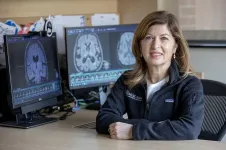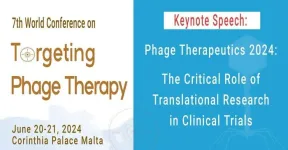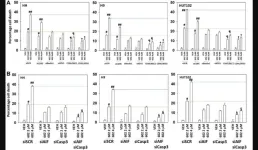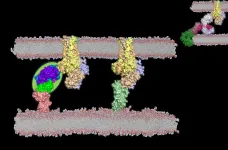(Press-News.org) An SFU-led collaboration has designed the first synthetic protein-based motor which harnesses biological reactions to fuel and propel itself.
“Imagine if a Roomba could be powered only by the dirt it picks up,” says SFU Physics professor Nancy Forde, one of the authors of the study.
The team’s paper, led by SFU Physics PhD graduate Chapin Korosec and published today in Nature Communications, describes a protein-based molecular motor called “The Lawnmower,” which has been designed to cut a lawn of peptide “grass.” The motor uses the digestive enzyme trypsin to cut the peptides and convert them into the energy it needs to propel itself.
The researchers at SFU and in Lund, Sweden demonstrated that the Lawnmower is capable of self-guided motion and can be directed in specific directions using a specially designed track, an important step towards their implementation in a variety of settings.
The team’s findings build on decades of research on the role and function of molecular motors in organisms. As the researchers explain, all living systems, from humans to plants to bacteria, are kept alive by protein-based molecular motors. These motors convert chemical energy from one form into another to do useful work such as facilitating cell division, delivering cargo, swimming towards food or light, and maintaining healthy tissues.
The Lawnmower is the first artificial motor device created with proteins from nature. As Forde explains, these experiments help researchers test our understanding of how molecular motors work in nature.
“If the rules that we’ve learned from studying nature’s molecular motors are correct and sufficient, then we should be able to build motors out of different protein parts and have them work in expected ways,” she says.
In the future molecular motors may have important applications in medicine and biocomputing. In the human body, motor proteins are especially important for transporting cargo within neurons. Knowing how these molecular machines work may be key to understanding and treating motoneuron diseases such as multiple sclerosis and spastic paraplegia.
Molecular machines designed to mimic biological processes may also help healthcare providers deliver more targeted treatment for diseases.
“Influenza is thought to work as a molecular motor to infiltrate the area around cells in order to infect them," Forde says. “Maybe synthetic motors could use the same approach, but rather than infecting cells, they could be engineered to deliver drug payloads to specifically target diseased cells.”
“We are inspired by the Nobel-prize-winning physicist, Richard Feynman, who famously wrote ‘What I cannot create, I do not understand.’ Our team’s work aims to test our understanding of the fundamental operational principles of molecular machines by trying to create them from scratch.”
END
SFU-led research team designs a cutting-edge protein lawnmower
2024-02-26
ELSE PRESS RELEASES FROM THIS DATE:
Metal in glitter impairs aquatic plant growth, study shows
2024-02-26
Glitter is used in a wide array of colors and shapes in apparel, footwear, cosmetics, makeup, handbags, festive decorations, arts and crafts, and jewelry, among many other applications. During the Carnival holidays, hundreds of thousands of Brazilians cover parts of their bodies with it while dancing in the streets. Its brilliance is dazzling but it is considered an emerging pollutant by many scientists: like other microplastics (small plastic pieces less than 5 mm long), it is not filtered by wastewater treatment plants and ends up in rivers and the sea, interfering with aquatic life in various ways.
A study conducted at the Federal University of ...
Scientists assemble a richer picture of the plight and resilience of the foothill yellow-legged frog
2024-02-26
(Santa Barbara, Calif.) — Up to only a few inches in length, with a lemon-hued belly, the foothill yellow-legged frog may seem unassuming. But its range once stretched from central Oregon to Baja California. In 2023, it was listed under the federal Endangered Species Act. Its rapidly decreasing range is due in part to a fungal pathogen called Batrachochytrium dendrobatidis, or Bd, that has devastated amphibians around the world.
A team of researchers, including UC Santa Barbara’s Andrea Adams, has conducted the most comprehensive study to date ...
Neuropsychiatric symptoms predict which patients with mild cognitive impairment develop Alzheimer’s disease.
2024-02-26
As the years add up, it's common to notice slight changes in our ability to remember and think. Older people who have more marked changes than their peers can be diagnosed with mild cognitive impairment (MCI). Currently, we can’t easily predict which of these patients will develop Alzheimer’s disease and which will not.
“It's hard to predict which patients will have a more rapid progression and receive a diagnosis of dementia,” said Maria Vittoria Spampinato, M.D., division director of Neuroradiology at the Medical University of South Carolina.
“It’s important ...
Resurrecting niobium for quantum science
2024-02-26
For years, niobium was considered an underperformer when it came to superconducting qubits. Now scientists supported by Q-NEXT have found a way to engineer a high-performing niobium-based qubit and so take advantage of niobium’s superior qualities.
When it comes to quantum technology, niobium is making a comeback.
For the past 15 years, niobium has been sitting on the bench after experiencing a few mediocre at-bats as a core qubit material.
Qubits are the fundamental components of quantum devices. One qubit type relies on superconductivity to process information.
Touted for its superior qualities as a superconductor, niobium was always a promising ...
Long-term data reveals SARS-CoV-2 infection and vaccine-induced antibody responses are long-lasting
2024-02-26
A long-term analysis conducted by leading microbiologists at the Icahn School of Medicine at Mount Sinai reveals that antibody responses induced by COVID-19 vaccines are long-lasting. The study results, published online in the journal Immunity on February 22, challenge the idea that mRNA-based vaccine immunity wanes quickly.
The emergence of SARS-CoV-2, the virus that causes COVID-19, in late 2019 sparked the global pandemic that is now in its fifth year. Vaccines that were developed at record speed have saved millions of lives. However, the emergence of SARS-CoV-2 variants and waning immunity have decreased ...
Shaping the future of phage therapy: The 7th World Conference on Targeting Phage Therapy in Malta aims to transform clinical trials through translational research
2024-02-26
The 7th World Conference on Targeting Phage Therapy 2024, two-day event dedicated to advancing the field of phage research and therapy will be hosted at Corinthia Palace Malta on June 20-21.
Robert T. Schooley, M.D., Professor of Medicine at the University of California, San Diego, Co-Director of the Center for Innovative Phage Applications and Therapeutics, and member of the Executive Committee for the University of California Disaster Resilience Network, will introduce the messages and strategies behind phages therapy 2024.
His talk titled “Phage Therapeutics 2024: Essential Translational Research Components for ...
GZ17-6.02 with bexarotene kills mycosis fungoides cells
2024-02-26
“The present studies were performed to extend our knowledge of GZ17-6.02 biology from that known in solid tumor cell types such as prostate cancer cells to liquid tumor cell types, for example, mycosis fungoides.”
BUFFALO, NY- February 26, 2024 – A new research paper was published in Oncotarget's Volume 15 on February 8, 2024, entitled, “GZ17-6.02 interacts with bexarotene to kill mycosis fungoides cells.”
In this new study, researchers Michael R. Booth, Laurence Booth, Jane L. Roberts, Cameron West, and Paul Dent from Virginia Commonwealth University and Genzada Pharmaceuticals investigated the therapeutic agent GZ17-6.02, composed of curcumin, ...
University of Tennessee Health Science Center professor awarded $1.5m to study 'root causes' of disparity in breast cancer survival of Black women and white women
2024-02-26
Memphis, Tenn. (February 26, 2024) – Shelley White-Means, PhD, a professor of Health Economics in the Department of Interprofessional Education and the director of the Consortium for Health Education, Economic Empowerment and Research (CHEER) at UT Health Science Center, recently received a $1.5 million, four-year grant from the National Institute on Minority Health and Health Disparities to explore the root causes of the disparity in breast cancer survival of Black women compared to white women.
Dr. White-Means and a team will look beyond the social determinants of health to explore what she terms “the intersectionality of race, ...
Steering and accelerating electrons at the microchip scale
2024-02-26
Stanford researchers are getting closer to building a tiny electron accelerator based on “accelerator-on-a-chip” technology with broad potential applications in studying physics as well as medical and industrial uses.
The researchers have demonstrated that a silicon dielectric laser accelerator, or DLA, can now both speed up and confine electrons, creating a focused beam of high-energy electrons. “If the electrons were microscopic cars, it’s as if, for the first time, we’re steering and we have our foot on the gas,” said Payton Broaddus, PhD ’23 in electrical engineering and the lead author on a paper published on ...
City of Hope scientists devise novel strategy to seek and destroy leukemia stem cells
2024-02-26
FINDINGS
Scientists at City of Hope, one of the largest cancer research and treatment organizations in the United States, have devised an innovative approach to target and destroy hard-to-kill leukemia stem cells. The journal Blood published the preclinical findings today.
By overcoming challenges, such as drug resistance and treatment relapse common to patients with acute myeloid leukemia (AML), the therapy method could provide a less toxic and more effective approach for older and sicker patients who don’t quality for stem cell transplants — currently the only cure for AML available.
Type II interferon (IFNy), a substance produced by immune cells, disrupts ...







